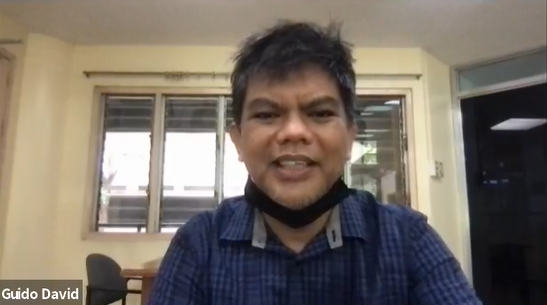OCTA fellow ‘optimistic’ about PH pandemic exit but warns of ‘uncertainty’

OCTA Research fellow Dr. Guido David in another Pandesal Forum, this one conducted in November 2021. (Screengrab from Pandesal Forum-Kamuning Bakery Cafe Facebook Live)
MANILA, Philippines — An OCTA Research fellow, Dr. Guido David, is “optimistic” that the Philippines could gradually get out of the COVID-19 pandemic this 2022, but he warns of “uncertainty.”
“There is definitely uncertainty in the picture. We can be more optimistic…We are being optimistic that this could be the end of the pandemic,” David said at the Pandesal Forum on Monday.
But then he warned: “I’m not saying it is the end of the pandemic, I’m just expressing my optimism. But I reserve some caution because there might be some new variants that we are not aware about, and that will definitely change this idea of endemicity.”
“We just have to hope and pray that it will turn out to be OK. That this Tiger year will be the exit out of the pandemic,” he added.
He made the statement after being asked to react to a recent statement by renowned Thai virologist, Dr. Yong Poovorawan, who dismissed the idea that COVID-19 would become endemic.
According to Yong, “endemic” describes a disease that is confined to a certain area while “pandemic” describes a worldwide outbreak.
COVID-19, Yong pointed out, had spread globally and would not become endemic.
READ: Why COVID-19 will never become endemic
“I respect the opinion — the perspective of different experts, different scientists all over the world. Some are arguing this and that and that’s fair in the scientific community,” David said.
Still, he said there was “still a lot that we don’t know about” the virus.
“Some experts have a more pessimistic perspective — I understand that as well — and some have a more optimistic perspective. Because the studies are based on limited information, we are really not at the point where we can definitely say that this will happen or this will [not] happen,” he said.
“The projections, yes, we can make projections because those are based on trends. But as far as what the future holds, I can’t really say that,” he added.
No ‘rapid exit’
David said the Philippines would likely not have a “rapid exit” from the pandemic.
“The exit could be prolonged, we’re not necessarily seeing a rapid exit out of the pandemic and into the endemic because we still have to wait for some data,” he said.
“The positivity rate is still high,” he added, also noting that a lot of people are still doing self-tests.
He also cited the hospital utilization rate, which “could still be lower.”
“There are many other factors, and that will prolong the exit. And this is something that really has to be discussed in detail, especially by the IATF [Inter-Agency Task Force for the Management of Emerging Infectious Diseases], DOH [Department of Health], and other experts and medical doctors because there will be definitely different perspectives on the exit,” he said.
Meanwhile, he reminded people not to belittle the threat of the coronavirus.
“The word ‘endemic — it’s contentious and people have different interpretations… Firstly, we should not minimize the threat of the virus, or Omicron, even as we are seeing more mild cases, we’re not minimizing the threat of the virus itself,” he said.
“When we try to change our mindset to being endemic, most people might think that there’s no threat but the reality is that the threat is still there,” he added.
What should be done?
Though recognizing a “high level” of vaccination in Metro Manila, David said there was still room for improvement, especially in the provinces.
“We’re seeing mild cases mainly because of the high level of vaccination that we have in the NCR [National Capital Region] and many other urbanized cities. But there are still provinces in the country with low vaccination coverage, and I think that will be one aspect which we still need to improve significantly on as we exit the pandemic,” he said.
“I’m not the authority to set a benchmark, but there should be benchmarks — like how much vaccine should have been given in a province before we can basically exit the pandemic,” he added.
He also stressed the importance of vaccinating children and adolescents.
“As we exit the pandemic, we are also moving into a stage wherein face-to-face classes will be back. The level of vaccination, especially of children and adolescents, will also be important factors when we move back to having face-to-face classes,” David said.
On Monday, the Philippines tallied 14,546 additional COVID-19 infections, with active cases slightly decreasing to 190,818.
READ: PH logs 14,546 new COVID-19 cases, 26,500 latest recoveries